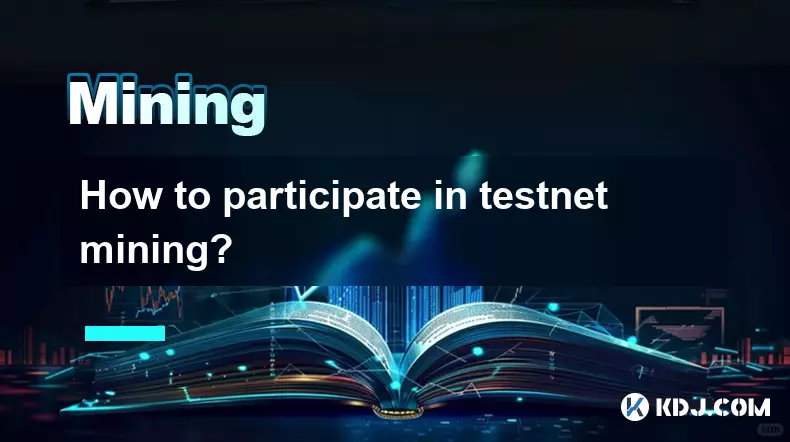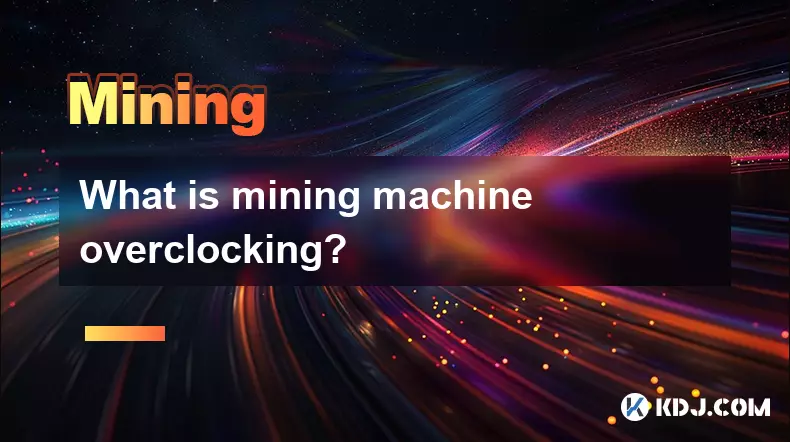-
 bitcoin
bitcoin $109667.069529 USD
-3.03% -
 ethereum
ethereum $3936.685804 USD
-4.07% -
 tether
tether $1.000493 USD
0.01% -
 xrp
xrp $2.771823 USD
-4.74% -
 bnb
bnb $957.805027 USD
-5.34% -
 solana
solana $196.735100 USD
-6.68% -
 usd-coin
usd-coin $0.999727 USD
-0.01% -
 dogecoin
dogecoin $0.227355 USD
-5.12% -
 tron
tron $0.335205 USD
-0.81% -
 cardano
cardano $0.779256 USD
-3.59% -
 ethena-usde
ethena-usde $0.999900 USD
-0.06% -
 hyperliquid
hyperliquid $42.492095 USD
-6.61% -
 chainlink
chainlink $20.501853 USD
-4.34% -
 avalanche
avalanche $28.952606 USD
-11.21% -
 stellar
stellar $0.356038 USD
-3.93%
What software is used for crypto mining?
HiveOS is a powerful, web-based operating system for managing GPU and ASIC mining farms, offering remote monitoring, real-time analytics, and automated firmware updates.
Sep 12, 2025 at 09:36 am

Popular Software Tools for Cryptocurrency Mining
1. CGMiner is one of the oldest and most widely used mining applications, supporting both GPU and ASIC mining hardware. It operates across multiple platforms including Windows, macOS, and Linux, offering users detailed control over fan speed, temperature monitoring, and clock settings.
2. BFGMiner was designed with advanced users in mind, particularly those working with FPGA and ASIC devices. It includes features like dynamic clocking, a modular system interface, and support for various mining protocols such as Stratum and Getwork.
3. EasyMiner acts as a GUI-based wrapper for CGMiner and BFGMiner, simplifying the mining process for beginners. It supports Windows, Android, and Linux systems and provides an intuitive dashboard to monitor hash rates and power consumption.
4. Awesome Miner offers centralized management for large-scale mining operations. With support for over 50 different miners, it enables automation, alert notifications, and performance tracking across multiple rigs through a single interface.
5. MultiMiner streamlines the switching between different cryptocurrencies based on profitability. It integrates directly with popular mining pools and automatically adjusts settings to optimize returns while maintaining user-friendly navigation.
GPU Mining Software Options
1. PhoenixMiner remains a top choice for Ethereum mining using AMD and NVIDIA graphics cards, delivering high efficiency and low developer fees. It communicates directly with mining pools using the Stratum protocol and supports dual mining configurations.
2. TeamRedMiner is tailored specifically for AMD GPUs, providing strong stability and excellent memory overclocking capabilities. Its lightweight design reduces system overhead while maximizing hashrate output.
3. GMiner leverages both CPU and GPU resources, supporting algorithms like Cuckoo Cycle and Ethash. Known for its robust security and resistance to malware injection, it's frequently updated to maintain compatibility with evolving network standards.
4. T-Rex Miner focuses on performance and simplicity, supporting numerous algorithms including KawPow and Zcoin. It delivers consistent uptime and minimal downtime during pool switches or network fluctuations.
5. NBMiner supports multi-algo mining and automatic benchmarking, making it ideal for miners who frequently switch between coins. It also includes built-in protection against unauthorized access and remote execution.
ASIC-Compatible Mining Applications
1. Braiins OS+ is a firmware upgrade for ASIC miners that boosts efficiency by up to 25%. It replaces the factory software on devices from Bitmain, MicroBT, and others, introducing advanced tuning options and real-time analytics.
2. HiveOS is not a miner itself but a complete operating system designed for managing ASICs and GPU farms remotely. Through its web-based dashboard, users can configure miners, monitor temperatures, update firmware, and receive alerts when anomalies occur.
3. Antminer Official Firmware comes pre-installed on Bitmain’s ASIC units. While limited in customization compared to third-party alternatives, it ensures full warranty coverage and seamless integration with major mining pools.
4. VNISH Firmware enhances ASIC performance beyond factory limits, particularly on older S9 models. It unlocks hidden potential through optimized voltage regulation and frequency scaling, though it may void manufacturer warranties.
5. LuxOS targets professional mining facilities, offering enhanced reporting tools, energy consumption analysis, and API access for custom integrations into larger data center infrastructures.
Frequently Asked Questions
What is the best mining software for beginners?EasyMiner and MultiMiner are highly recommended for newcomers due to their graphical interfaces and automated setup processes. They reduce the complexity involved in configuring command-line tools while still connecting reliably to major mining pools.
Can I use the same software for both GPU and ASIC mining?Most mining software specializes in either GPU or ASIC operations. CGMiner and BFGMiner are exceptions, offering support for both, though optimal performance usually requires device-specific applications like PhoenixMiner for GPUs or Braiins OS for ASICs.
Is it safe to use third-party firmware on ASIC miners?While third-party firmware like VNISH or Braiins OS can significantly improve efficiency, they often void the manufacturer's warranty. Users should back up original firmware and understand the risks of instability or bricking before installation.
Do mining software tools require constant internet connectivity?Yes, mining software must remain connected to the internet to communicate with mining pools, submit proof-of-work shares, and receive updated block data. Interruptions in connectivity result in lost hashing time and reduced earnings.
Disclaimer:info@kdj.com
The information provided is not trading advice. kdj.com does not assume any responsibility for any investments made based on the information provided in this article. Cryptocurrencies are highly volatile and it is highly recommended that you invest with caution after thorough research!
If you believe that the content used on this website infringes your copyright, please contact us immediately (info@kdj.com) and we will delete it promptly.
- Big Rocking Horse, Coin, and Ice Cream: An Aussie Icon's Sweet Ride
- 2025-09-26 10:45:16
- Pi Network, Price Forecast, and the Meme Market: A New York Minute
- 2025-09-26 10:25:14
- AIXA Miner: Revolutionizing Bitcoin Mining with Cloud Solutions
- 2025-09-26 10:45:16
- Mid-Cap Altcoins: Crypto Buys with Breakout Potential
- 2025-09-26 10:50:01
- BullZilla Presale: Riding the Crypto Wave in September 2025
- 2025-09-26 10:50:01
- Litecoin ETF Buzz, XRP Breakout Dreams, and BlockDAG's Deployment: Crypto's Wild West in '25
- 2025-09-26 10:50:01
Related knowledge

The difference between staking and mining
Sep 24,2025 at 05:18am
Understanding Staking in the Cryptocurrency Ecosystem1. Staking involves holding funds in a cryptocurrency wallet to support the operations of a block...

How to participate in testnet mining?
Sep 22,2025 at 09:18am
Understanding Testnet Mining in the Crypto Ecosystem1. Testnet mining is a method used by blockchain developers to simulate real-world conditions on a...

How to dispose of abandoned mining machines?
Sep 19,2025 at 08:19pm
Assessing the Condition of Abandoned Mining Rigs1. Begin by inspecting each mining machine for visible damage, corrosion, or missing components. Machi...

How to identify high-quality mining pools?
Sep 21,2025 at 03:19pm
Reputation and Track Record1. A mining pool’s reputation is built over time through consistent performance and transparency. Pools that have operated ...

Advantages of decentralized mining pools
Sep 20,2025 at 04:36pm
Enhanced Security and Resistance to Censorship1. Decentralized mining pools operate on blockchain-based smart contracts, eliminating the need for a ce...

What is mining machine overclocking?
Sep 21,2025 at 07:19pm
Understanding Mining Machine Overclocking1. Mining machine overclocking refers to the process of increasing the operating frequency of a cryptocurrenc...

The difference between staking and mining
Sep 24,2025 at 05:18am
Understanding Staking in the Cryptocurrency Ecosystem1. Staking involves holding funds in a cryptocurrency wallet to support the operations of a block...

How to participate in testnet mining?
Sep 22,2025 at 09:18am
Understanding Testnet Mining in the Crypto Ecosystem1. Testnet mining is a method used by blockchain developers to simulate real-world conditions on a...

How to dispose of abandoned mining machines?
Sep 19,2025 at 08:19pm
Assessing the Condition of Abandoned Mining Rigs1. Begin by inspecting each mining machine for visible damage, corrosion, or missing components. Machi...

How to identify high-quality mining pools?
Sep 21,2025 at 03:19pm
Reputation and Track Record1. A mining pool’s reputation is built over time through consistent performance and transparency. Pools that have operated ...

Advantages of decentralized mining pools
Sep 20,2025 at 04:36pm
Enhanced Security and Resistance to Censorship1. Decentralized mining pools operate on blockchain-based smart contracts, eliminating the need for a ce...

What is mining machine overclocking?
Sep 21,2025 at 07:19pm
Understanding Mining Machine Overclocking1. Mining machine overclocking refers to the process of increasing the operating frequency of a cryptocurrenc...
See all articles










































































